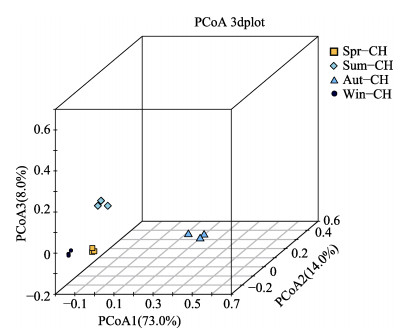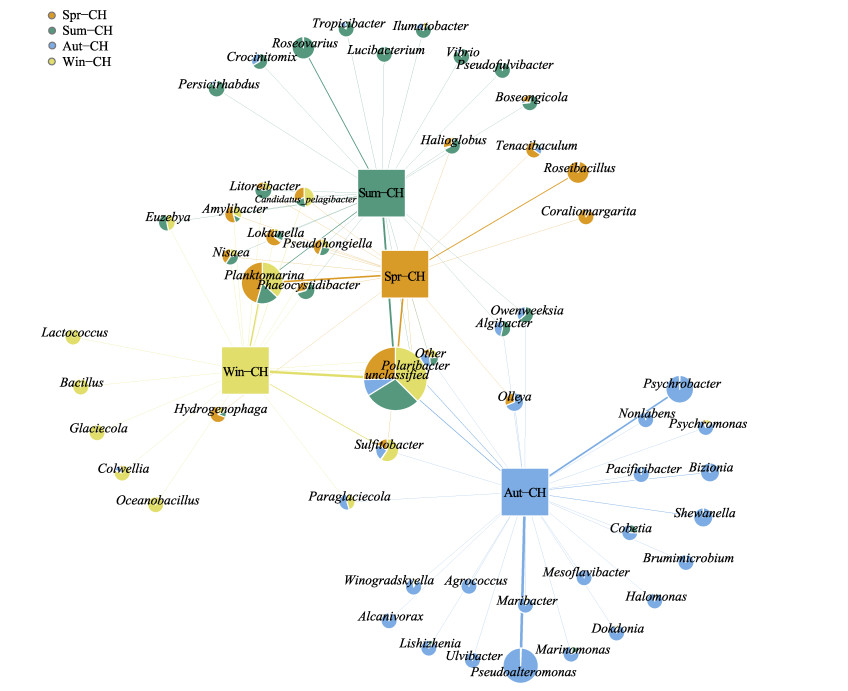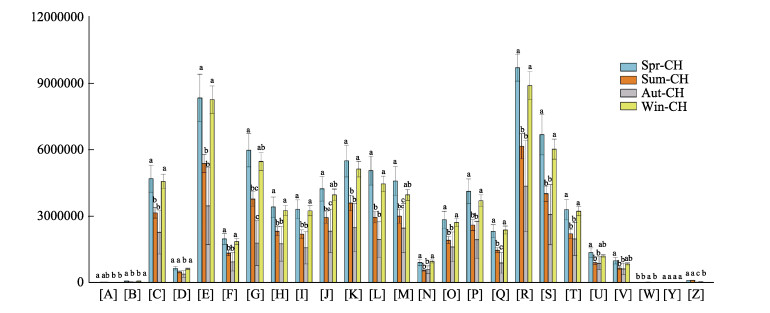刺参(Apostichopus japonicus)是具有较高经济、营养及药用价值的海水养殖生物(陈士国, 2010; Roggatz et al, 2018; 曹荣等, 2020)。池塘养殖作为一种重要的刺参增养殖模式,已经成为刺参养殖产业的重要组成部分(赵艳芳等, 2018)。然而,随着刺参养殖产业的迅速发展,养殖水体的污染问题日益严重,对养殖生物产生了一定危害。
养殖池塘水体的微生物群落,不仅在水体物质与能量循环中具有重要作用,而且对养殖生物的健康存在直接或间接的影响(王鑫毅等, 2019)。深入研究水体微生物结构及功能,不仅可以了解微生物对养殖生物的影响,也可以利用微生物的特有性质和功能改善水质条件。目前,利用水体微生物某些特性,对水中污染物进行转移、转化及降解等一系列生物处理方法和技术,已得到广泛的认可和利用(付战勇等, 2019)。
刺参作为海洋生物,水体环境是其生存生长的主要场所,也是刺参病原菌来源的主要途径(孙静等, 2019)。近年来,关于刺参养殖池塘水体菌群的研究工作越来越受到研究者关注。Gao等(2010)在研究刺参养殖池塘水体菌群结构时发现,变形菌门(Proteobacteria)、放线菌门(Actinobacteria)、拟杆菌门(Bacteroidetes)等是池塘水体中主要优势菌,相对丰度为69.01%~97.21%。窦研等(2016)对普兰店、庄河、旅顺不同地区刺参养殖池塘水体菌群结构特征研究结果显示,所调查区域水体优势菌门均为变形菌门和拟杆菌门。关晓燕等(2010)对辽宁普兰店高温季节刺参养殖水体菌群结构特征的研究表明,6~9月水体细菌数量不断上升,且优势菌主要隶属于变形菌门。
目前,已有的研究大多是基于形态学观察及纯培养等传统方法(冯振飞等, 2008; 高菲等, 2010; 李彬等, 2010),具有一定的局限性,不能准确全面地反映养殖环境中微生物群落结构的真实情况。近年来,高通量测序技术结合生物信息学方法,为全面解析菌群结构和功能特征开启新途径(温崇庆等, 2016; 刘开辉等, 2017; 肖汉玉等, 2019; 来守超等, 2020)。
本研究选取辽宁长海刺参养殖池塘作为研究对象,利用高通量测序技术,解析不同季节刺参养殖池塘水体菌群结构与功能特征,以期为刺参养殖池塘水体微生态调控提供一定的理论依据。
1 材料与方法 1.1 样品采集采样选取的刺参养殖池塘仅养殖刺参单一品种,且全年不投喂微生态制剂。池塘面积约为0.1 km2,水深为2~3 m,水源来自近海海域,利用潮汐带来的潮差进水和排水。分别于2019年3月(春季)、6月(夏季)、9月(秋季)和12月(冬季),利用玻璃采水器采集辽宁长海(39°16′42″N,122°36′5″E)同一刺参养殖池塘上层(离水面30 cm处)和下层(离池底30 cm处)水样各4 L,低温条件下带回实验室。水样经0.8 μm无菌滤膜抽滤后,测定水质指标;再经0.22 μm醋酸纤维素滤膜抽滤,滤膜用于细菌总DNA的提取。
1.2 环境因子的测定采用HACH(HQd)水质分析器,现场测定盐度(S)、温度(T)、酸碱度(pH值)、溶解氧(DO)、氧化还原电位(ORP)。总氮(TN)、总磷(TP)、氨氮(NH4+-N)、硝酸盐(NO3–-N)、亚硝酸盐(NO2–-N)、磷酸盐(PO43–-P)等理化参数测定按照GB17378-2007海洋监测规范进行。
1.3 DNA提取选用OMEGA Soil DNA试剂盒提取刺参养殖池塘水体样品总DNA,使用NanoDrop 2000超微量分光光度计和1%琼脂糖凝胶电泳检测所提取DNA的浓度、纯度和完整性。
1.4 PCR扩增与高通量测序细菌16S rRNA基因V3~V4片段的扩增引物为341F (5′-CCTACGGGNGGCWGCAG-3′)和806R (5′-G GACTACHVGGGTATCTAAT-3′),应用Illumina MiSeq测序平台完成序列测序。
1.5 数据分析采用Usearch软件,以97%阈值开展OTUs (Operational taxonomic units)操作分类单元聚类。采用RDPclassifier软件以阈值0.8进行物种分类操作,低于该阈值的分类结果划归为Unclassified一类。利用Mothur软件进行多样性分析。基于物种分类结果,得到在不同水平上各Rank的丰度值,采用STAMP软件,比较样本或组间丰度差异,筛选条件为P < 0.05。
2 结果与分析 2.1 环境因子监测辽宁长海刺参养殖池塘不同季节的水体环境因子监测结果见表 1。根据中华人民共和国《海水水质标准(GB 3097-1997)》,所有采样点水质均符合国家Ⅰ类海水标准。从表 1可以看出,所监测水质指标均呈现显著性季节差异。其中,水体盐度在春季和冬季最高,夏季和秋季较低。从春季到冬季,水体溶解氧、总有机碳(TOC)、pH、硫化物和化学需氧量(COD)均表现出先降低后升高的趋势,TN、NO2–-N、PO43–-P和TN表现出逐渐降低的趋势,氧化还原电位(ORP)、TP、NH4+-N和NO3–-N则呈先升高后降低的趋势。
|
|
表 1 不同季节刺参养殖池塘水体环境因子 Tab.1 Environmental factors of water in A. japonicus culture pond in different seasons |
不同季节刺参养殖池塘水体样品经检测得到原始序列40540~71190条,其中,有效序列33663~67711条,聚类于372~835个OTUs。测序覆盖率为95.94%~ 99.66%,表明测序结果真实反映样本信息(表 2)。
|
|
表 2 高通量测序结果 Tab.2 High throughput sequencing results |
辽宁长海刺参养殖池塘水体菌群丰度和多样性均呈显著的季节性差异(表 2)。根据菌群Chao指数和ACE指数可知,夏季水体菌群丰度最高,秋季水体菌群丰度最低,春季和冬季介于夏季和秋季之间。根据Shannon和Simpson指数可知,夏季水体菌群多样性最高,秋季水体菌群多样性最低,冬季略高于春季。
2.3.2 β多样性在OTU水平上,基于加权Unifrac距离对所有样本进行三维坐标分析,结果见图 1。其中,第1主坐标(PCoA1)的贡献率为73.0%,第2主坐标(PCoA2)的贡献率为14.0%,第3主坐标(PCoA3)的贡献率为8.0%,三者累计贡献率为95.0%。不同组别样品分散于不同象限,表明池塘样品组间菌群结构具有显著差异。养殖池塘四季水体组内样品大多聚集在一起,即显示出较好的生物学重复。秋季水体菌群结构与其他3个季节相比具有显著差异(P < 0.05),春季和冬季水体菌群相似性最高。

|
图 1 不同季节水体菌群Unifrac PCoA图 Fig.1 Unifrac PCoA of water bacterial community in different seasons |
不同季节刺参养殖池塘水体菌群结构特征如图 2所示。从门水平上看,不同季节刺参养殖池塘水体优势菌门主要隶属于变形菌门和拟杆菌门,二者相对丰度最高可达90%以上。其中,变形菌门在全年各季节均为第一优势菌门,相对丰度约占水体菌群的49.66%~70.02%。拟杆菌门均是不同季节的次优势菌门,春、夏、秋和冬的相对丰度分别为27.35%、26.66%、23.33%和19.98%。

|
图 2 不同季节水体菌群组成的相对丰度 Fig.2 Relative abundance of water bacterial community in different seasons |
从属水平上看,春季刺参养殖池塘水体主要优势菌属为Planktomarina、Sulfitobacter、Litoreibacter、Loktanella、Amylibacter、Candidatus_Pelagibacter、Phaeocystidibacter、Olleya和Polaribacter。夏季水体的主要优势菌属隶属于Planktomarina、Roseovarius、Litoreibacter、Candidatus_Pelagibacter、Vibrio、Halioglobus、Phaeocystidibacter、Algibacter和Pseudofulvibacter。秋季水体的主要优势菌属隶属于Pseudoalteromomas、Psychrobacter、Shewanella、Plaribacter、Olleya和Bizionia。冬季水体的主要优势菌属隶属于Planktomarina、Sulfitobacter、Candidatus_Pelagibacter、Amylibacter和Polaribacter。优势菌属组成存在显著性季节差异(P < 0.05)。
2.5 差异菌群结构特征属水平下的水体菌群相似性分析结果表明,不同季节的辽宁长海刺参养殖池塘水体菌群存在显著性差异。其中,秋季与其他季节相比,共有菌群种类较少,相似性较低(图 3)。

|
图 3 属水平下水体菌群network图 Fig.3 Network diagram of water bacterial community in genus |
LEfSe分析结果显示(图 4),春、夏和冬季水体特异性菌门分别为疣微菌门(Verrucomicrobia)、放线菌门和厚壁菌门(Firmicutes),秋季无特异性菌门。春季特异性菌属主要隶属于Planktomarina、Amylibacter和Roseibacillus;夏季特异性菌属主要隶属于Owenweeksia、Phaeocystidibacter和Euzebya;秋季特异性菌属隶属于Winogradskyella、Cryomorphaceae、Bizionia和Psychrobacter;冬季特异性菌属主要隶属于Candidatus_Pelagibacter和Sulfitobacter。

|
图 4 不同季节水体菌群LEfSe分析 Fig.4 LEfSe analysis of water bacterial community in different seasons |
不同季节刺参养殖池塘水体菌群功能预测结果见图 5。比对COGs数据库25种功能蛋白,水体菌群中24种功能蛋白存在显著性差异(P < 0.05)。

|
图 5 基于COG数据库菌群功能注释 Fig.5 The function of bacterial community prediction based on COG database [A]:RNA的处理和修饰;[B]:染色质结构与动力学;[C]:能量的生产与转换;[D]:细胞周期控制、细胞分裂和染色体分割;[E]:氨基酸的运输和代谢;[F]:核苷酸运输与代谢;[G]:碳水化合物运输和代谢;[H]:辅酶的运输和代谢;[I]:脂质转运与代谢;[J]:翻译、核糖体结构与生物发生;[K]:转录;[L]:复制、重组和修复;[M]:细胞壁/膜/包膜生物发生;[N]:细胞的能动性;[O]:翻译后修饰、蛋白质转换和伴侣蛋白;[P]:无机离子运输与代谢;[Q]:次生代谢物的生物合成、运输和分解代谢;[R]:一般的功能预测;[S]:未知功能;[T]:信号传导机制;[U]:细胞内运输、分泌和囊泡运输;[V]:防御机制;[W]:细胞外结构;[Y]:核结构;[Z]:细胞骨架 [A]: RNA processing and modification; [B]: Chromatin structure and dynamics; [C]: Energy production and conversion; [D]: Cell cycle control, cell division, chromosome partitioning; [E]: Amino acid transport and metabolism; [F]: Nucleotide transport and metabolism; [G]: Carbohydrate transport and metabolism; [H]: Coenzyme transport and metabolism; [I]: Lipid transport and metabolism; [J]: Translation, ribosomal structure and biogenesis; [K]: Transcription; [L]: Replication, recombination and repair; [M]: Cell wall/membrane/envelope biogenesis; [N]: Cell motility; [O]: post-translational modification, protein turnover, and chaperones; [P]: inorganic ion transport and metabolism; [Q]: Secondary metabolites biosynthesis, transport, and catabolism; [R]: General function prediction only; [S]: Function unknown; [T]: Signal transduction mechanisms; [U]: Intracellular trafficking, secretion, and vesicular transport; [V]: Defense mechanisms; [W]: Extracellular structures; [Y]: Nuclear structure; [Z]: Cytoskeleton |
春季和冬季水体菌群功能具有较高的相似性,表现为功能编码[C, E, F, G, H, I, Q, P, M, N, O, T, U, V, G, J, M]的17种功能蛋白显著上调(P < 0.05)。其中,与代谢相关的全部功能均增强,具体表现在[C]能量的生产与转换,[E]氨基酸的运输和代谢,[F]核苷酸运输与代谢,[G]碳水化合物运输和代谢,[H]辅酶的运输和代谢,[I]脂质转运与代谢,[Q]次生代谢物的生物合成、运输和分解代谢,[P]无机离子运输与代谢方面。在细胞过程与信号传导方面,菌群功能的增强体现在[M]细胞壁/膜/包膜生物发生,[N]细胞的能动性,[O]翻译后修饰、蛋白质转换和伴侣蛋白,[T]信号传导机制,[U]细胞内运输、分泌和囊泡运输,[V]防御机制。在信息存储与处理方面,[K]转录与[L]复制、重组、修复相关功能蛋白显著增强。
与春季相比,夏季水体菌群功能编码[G, J, M]的功能蛋白显著下调(P < 0.05)。具体表现为[G]碳水化合物运输和代谢功能,[J]翻译、核糖体结构,[M]生物发生功能、细胞壁/膜/包膜生物相关功能的下降。
秋季水体菌群功能编码[D, Q, Z, W]的功能蛋白具有显著性差异(P < 0.05)。在细胞过程与信号方面,表现为[D]细胞周期控制、细胞分裂、染色体分裂,[Z]细胞骨架功能的下降,以及[W]细胞外结构相关功能的升高。在新陈代谢方面,具体表现为[Q]次生代谢物的生物合成、转运和分解代谢相关功能的下降。
3 讨论微生物作为养殖池塘生态系统的重要组成部分,同时,作为生产者和分解者,保证了养殖池塘生态系统中物质循环与能量供给,对维持生态系统平衡具有至关重要的作用(李博, 2013)。本研究利用高通量测序技术通过对刺参养殖池塘水体微生物16S rRNA基因V3~V4片段进行扩增测序,全面鉴定水体微生物种类特征,深入解析水体微生物组成情况,以期为养殖水体环境菌群调控和刺参养殖疾病防治提供一定的理论基础。
3.1 不同季节刺参养殖池塘水体优势菌群特征本研究结果显示,辽宁长海刺参养殖池塘水体不同季节优势菌门均为变形菌门和拟杆菌门,二者相对丰度之和最高可达90%以上,该结果与李建光等(2014)的研究报道相吻合。变形菌群作为第一优势菌门,主要是因为其在原核生物分子生物学分类或表型分类中占据了绝对的优势(Gupta, 2000)。拟杆菌门作为次优势菌门,是海洋浮游细菌的重要组成部分,其菌属能够产生胞外水解酶来降解生物大分子(如几丁质、琼脂等)(施云芬等, 2017),同时,拟杆菌门还能在发酵碳水化合物的同时有效分解纤维细胞壁的多糖,常常与脂质蛋白质等有机物的代谢转换有关,而这些有机物是水体碳循环的重要组成部分,在物质循环中具有重要作用(Chen et al, 2018)。
3.2 不同季节刺参养殖池塘水体差异菌群特征比较不同季节的辽宁长海刺参养殖池塘水体差异菌群结构特征。结果显示,春、夏和冬季具有显著性差异的菌门分别隶属于疣微菌门(16.01%)、放线菌门(11.67%)和厚壁菌门(2.01%);秋季相比于其他季节没有显著的特异性菌群。不同季节特异性菌群的相对丰度与水体的理化因子的相对含量有关,理化因子含量的改变对水体菌群的生长和分布丰度具有一定的影响。研究发现,水体理化因子为微生物生长和繁殖过程提供无机盐和有机物等营养物质,菌群结构特征往往受其所处环境中理化因子浓度的影响(张丽娜等, 2012; Nishiyama et al, 2018)。疣微菌门中的微生物广泛存在于水生生态系统中,在生物地球的氮循环中起着重要作用(Bergen et al, 2014; Sharp et al, 2014; Shen et al, 2017)。本研究关于长海刺参养殖池塘不同季节水体所有监测环境因子显示,春季水体总氮含量在四季中最高。池塘生态系统为保持其稳定性,春季水体疣微菌门相对丰度的增加在加快水体氮循环过程中发挥重要作用。具有抗高温特性的放线菌门作为夏季的差异菌门,在养殖池塘水体中具有降解淀粉、蛋白等大分子的功能,可以产生抗菌类物质,并能形成耐热、耐干孢子等优点,有成为益生菌的潜力(王蓉等, 2013)。本研究结果显示,环境温度越低,水体厚壁菌门细菌相对丰度越大。这是因为厚壁菌门下的芽孢杆菌纲大部分微生物,能够形成抗逆性极强的芽孢,从而具有极强的环境适应性(宋兆齐等, 2015)。此外,隶属于厚壁菌门的枯草芽孢杆菌(Bacillus subtilis)可以降低养殖水体中的硝酸盐和亚硝酸盐,能有效改善刺参养殖水体水质,提高机体消化酶和非特异性免疫酶活性,从而促进刺参生长(董春光等, 2015),推测与冬季水体中检测出较低含量的硝酸盐和亚硝酸盐有关。
3.3 不同季节刺参养殖池塘水体菌群功能特征通过比对COGs数据库25种功能蛋白,刺参养殖池塘水体菌群中24种功能蛋白存在显著性季节差异。春季和冬季水体菌群功能具有较高的相似性,但春季主要体现在新陈代谢等相关功能蛋白显著增强(P < 0.05);冬季主要表现在信息存储与处理、细胞过程与信号相关功能蛋白显著性增强(P < 0.05)。闫法军(2013)研究发现,水体菌群功能存在季节性差异与不同季节特异性菌群有关。本研究中,春季特异性菌门为疣微菌门,其参与水体氮循环,加速蛋白质代谢功能(Freitas et al, 2012),进而促使蛋白翻译速度的增强,引起信息存储于处理相关功能蛋白上调。冬季特异性菌门为厚壁菌门,其中代表性梭菌纲作为一种专性厌氧菌,具有很强的降解能力和代谢活性(宋景华等, 2013),一定程度上可以解释冬季水体菌群新陈代谢的增强。与春季和冬季相比,夏季的代谢、信息存储与处理、细胞过程与信号相关功能蛋白显著下降(P < 0.05)。放线菌门作为夏季的特异性菌群,产生的抗菌素种类与性质具有某些特性,能够抑制池塘水体中其他革兰氏阳性菌发挥功能(李文均等, 2002),引起夏季水体菌群相关功能蛋白显著下降。同时,放线菌能产生生物活性显著的次生代谢产物,这种次生代谢产物是生命活动非必需的一类小分子有机化合物,这类有机化合物的增多,使生命活动必需的化合物相对含量降低(王淑霞等, 2007),促使相关的功能蛋白显著下降。
4 结论本研究通过高通量测序技术揭示了辽宁长海刺参养殖池塘不同季节水体菌群结构与功能的特征。研究发现,随着季节的变化,长海刺参养殖池塘水体菌群结构和功能具有显著演替过程。养殖池塘水体菌群丰度和多样性的最高季节是夏季,最低季节是秋季。同时,水体菌群结构的季节性演替与其功能之间存在一定的相关性,但二者之间的相互作用机制还有待于进一步的深入探究。
Bergen B, Herlemann DPR, Labrenz M, et al. Distribution of the verrucomicrobial clade Spartobacteria along a salinity gradient in the Baltic Sea. Environmental Microbiology Reports, 2014, 6(6): 625-630 DOI:10.1111/1758-2229.12178 |
Chen CL, Liu WT, Chong ML, et al. Community structure of microbial biofilms associated with membrane-based water purification processes as revealed using a polyphasic approach. Applied Microbiology and Biotechnology, 2004, 63(4): 466-473 DOI:10.1007/s00253-003-1286-7 |
Chen SG. Structure and bioactivity analysis of several acid polysaccharides from sea animal: Searching for alternatives to Heparin. Doctoral Dissertation of Ocean University of China, 2010 [陈士国. 几种海洋动物酸性多糖的结构和活性研究. 中国海洋大学博士研究生学位论文, 2010]
|
Cao R, Wang SY, Zhao L, et al. Nutritional analysis and evaluation of Apostichopus japonicus gonads. Chinese Fishery Quality and Standards, 2020, 10(2): 23-30 [曹荣, 王善宇, 赵玲, 等. 仿刺参雄、雌性腺营养组成分析与评价. 中国渔业质量与标准, 2020, 10(2): 23-30 DOI:10.3969/j.issn.2095-1833.2020.02.003] |
Chen J, Robb CS, Unfried F, et al. Alpha- and beta-mannan utilization by marine Bacteroidetes. Environmental Microbiology, 2018, 20(11): 4127-4140 DOI:10.1111/1462-2920.14414 |
Dou Y, Zhao XW, Ding J, et al. Application of high-throughput sequencing for analyzing bacterial communities in earthen ponds of sea cucumber aquaculture in northern China. Oceanologia et Limnologia Sinica, 2016, 47(1): 122-129 [窦妍, 赵晓伟, 丁君, 等. 应用高通量测序技术分析北方刺参养殖池塘环境菌群结构. 海洋与湖沼, 2016, 47(1): 122-129] |
Dröge S, Limper U, Emtiazi F, et al. In vitro and in vivo sulfate reduction in the gut contents of the termite Mastotermes darwiniensis and the rose-chafer Pachnoda marginata. Journal of General and Applied Microbiology, 2005, 51(2): 57-64 DOI:10.2323/jgam.51.57 |
Du T. Seasonal variation of microflora and algal phase structure in sea cucumber aquaculture system and preliminary screening of probiotics. Masterxs Thesis of Shanghai Ocean University, 2016 [杜佗. 刺参大水面养殖系统中菌群、藻相结构的季节变化与益生菌的初步筛选. 上海洋大学硕士研究生学位论文, 2016]
|
Ding SY, Wang L, Xu HC, et al. Bacterial community structure and function in the intestinal tracts and culture environment of sea cucumber (Apostichopus japonicus). Chinese Journal of Ecology, 2019, 38(1): 210-220 [丁斯予, 王荦, 徐瀚晨, 等. 刺参肠道及养殖环境菌群结构与功能. 生态学杂志, 2019, 38(1): 210-220] |
Dong CG, Yang AG, Sun XJ, et al. The health-promoting effects of Bacillus subtilis in the culture of sea cucumber. Progress in Fishery Sciences, 2015, 36(3): 109-115 [董春光, 杨爱国, 孙秀俊, 等. 枯草芽孢杆菌(Bacillus subtilis)在刺参养殖中的益生作用. 渔业科学进展, 2015, 36(3): 109-115] |
Fu ZY, Ma YD, Luo M, et al. Research progress on the theory and technology of ecological protection and restoration abroad. Acta Ecologica Sinica, 2019, 39(23): 9008-9021 [付战勇, 马一丁, 罗明, 等. 生态保护与修复理论和技术国外研究进展. 生态学报, 2019, 39(23): 9008-9021] |
Feng ZF, Wang GL, Qian D, et al. Microbial flora and quantitative distribution of bacteria in culture ponds of mud crab Scylla serrata. Fisheries Science, 2008, 27(11): 574-577 [冯振飞, 王国良, 钱冬, 等. 锯缘青蟹养殖环境中细菌类群及其数量分布. 水产科学, 2008, 27(11): 574-577 DOI:10.3969/j.issn.1003-1111.2008.11.005] |
Freitas S, Hatosy S, Fuhrman JA, et al. Global distribution and diversity of marine Verrucomicrobia. ISME Journal, 2012, 6(8): 1499-1505 DOI:10.1038/ismej.2012.3 |
Fei YT. Study on relationship between microbial community and physical-chemical factors in culture environment and disease occurence of Apostichopus japonicus. Masterxs Thesis of Shanghai Ocean University, 2016 [费聿涛. 刺参养殖环境微生物和理化因子与刺参病害发生关系的研究. 上海海洋大学硕士研究生学位论文, 2016]
|
Fei YT, Li QF, Zhang Y, et al. Environmental factors causing skin ulcer symdrome occurrence in pond-cultured Apostichopus japonicus. Journal of Fishery Sciences of China, 2016, 23(3): 682-692 [费聿涛, 李秋芬, 张艳, 等. 池塘养殖刺参腐皮综合征发病环境因素分析. 中国水产科学, 2016, 23(3): 682-692] |
Gao F, Sun HL, Xu Q, et al. PCR-DGGE analysis of bacterial community composition in the gut contents of Apostichopus japonicus. Journal of Fishery Sciences of China, 2010, 17(4): 671-680 [高菲, 孙慧玲, 许强, 等. 刺参消化道内含物细菌群落组成的PCR-DGGE分析. 中国水产科学, 2010, 17(4): 671-680] |
Gao F, Xu Q, Yang HS. Seasonal variations of food sources in Apostichopus japonicus indicated by fatty acid biomarkers analysis. Journal of Fisheries of China, 2010, 34(5): 760-767 DOI:10.3724/SP.J.1231.2010.06768 |
Gao XY, Xu Y, Liu Y, et al. Bacterial diversity, community structure and function associated with biofilm development in a biological aerated filter in a recirculating marine aquaculture system. Marine Biodiversity, 2012, 42(1): 1-11 DOI:10.1007/s12526-011-0086-z |
Guan XY, Zhou ZC, Chen Z, et al. Bacteria diversity analysis on the water of sea cucumber (Apostichopus japonicus) culture pond under high-temperature season based on PCR-DGGE fingerprint technology. Transactions of Oceanology and Limnology, 2011, 30(5): 82-88 [关晓燕, 周遵春, 陈仲, 等. 应用PCR-DGGE指纹技术分析高温季节仿刺参养殖水环境中菌群多样性. 海洋湖沼通报, 2011, 30(5): 82-88] |
Gupta RS. The phylogeny of proteobacteria: Relationships to other eubacterial phyla and eukaryotes. FEMS Microbiology Reviews, 2000, 24(4): 367-402 DOI:10.1111/j.1574-6976.2000.tb00547.x |
He C, Huang GQ. On Apostichopus japonicus culture in China and major culture provinces. Fishery Information and Strategy, 2014, 29(1): 24-30 [何翠, 黄国强. 全国及主要刺参养殖省份刺参养殖状况分析. 渔业信息与战略, 2014, 29(1): 24-30] |
Lai SC, Fang XY, Tu B, et al. Methanogenic potential and community structure of coalbed-methane production water microbiome. Acta Microbiologica Sinica, 2020, 60(4): 727-738 [来守超, 方晓瑜, 涂波, 等. 典型煤层水微生物产甲烷潜力及其群落结构研究. 微生物学报, 2020, 60(4): 727-738] |
Li B, Rong XJ, Liao MJ, et al. Bacteria community in the intestine and culture environment of Apostichopus japonicus in winter. Marine Sciences, 2010, 34(4): 64-69 [李彬, 荣小军, 廖梅杰, 等. 冬季刺参养殖环境与肠道内细菌菌群的研究. 海洋科学, 2010, 34(4): 64-69] |
Li B. A preliminary study on bacterial productivity in different grass carp polyculture eco-systems and analysis of bacterial community. Masterxs Thesis of Ocean University of China, 2013 [李博. 草鱼混养生态系统细菌生产力和群落结构的实验研究. 中国海洋大学硕士研究生学位论文, 2013]
|
Li J, Liao MJ, Li B, et al. The characteristics of culturable bacterial microflora in the gastrointestinal tract of cultured sea cucumber (Apostichopus japonicus) during the early developmental stage and its relationship with environmental flora. Progress in Fishery Sciences, 2019, 40(2): 122-131 [李靖, 廖梅杰, 李彬, 等. 养殖刺参早期发育阶段体内可培养细菌的菌群特征及其与环境菌群相关性分析. 渔业科学进展, 2019, 40(2): 122-131] |
Li JG, Xu YP, Li XY, et al. Characterization of bacterial communities associated with the intestinal tracts and culture environment of sea cucumber (Apostichopus japonicus) in different culture seasons. Fisheries Science, 2014, 33(9): 562-568 [李建光, 徐永平, 李晓宇, 等. 不同养殖季节仿刺参肠道与养殖环境中菌群结构的特点. 水产科学, 2014, 33(9): 562-568] |
Li WJ, Zhang ZZ, Jiang CL. The advance on taxonomic of genue Thermoactinomyces. Acta Microbiologica Sinica, 2002, 42(6): 759-763 [李文均, 张忠泽, 姜成林. 高温放线菌属分类研究进展. 微生物学报, 2002, 42(6): 759-763] |
Liu KH, Ding XW, Zhang B, et al. High-throughput sequencing to reveal fungal diversity in hot springs of Rehai at Tengchong in Yunnan. Acta Microbiologica Sinica, 2017, 57(9): 1314-1322 [刘开辉, 丁小维, 张波, 等. 高通量测序分析云南腾冲热海热泉真菌多样性. 微生物学报, 2017, 57(9): 1314-1322] |
Liu WS, Guo XZ, Chen YL, et al. Analysis of microbial composition and function in the of farmed black-spot frog (Rana nigromaculata Howell). Journal of Economic Zoology, 2020, 24(1): 1-12 [刘文舒, 郭小泽, 陈彦良, 等. 养殖黑斑蛙(Rana nigromaculata Howell)肠道微生物结构与功能分析. 经济动物学报, 2020, 24(1): 1-12] |
Ma BB, Wu M, Wang ZY, et al. The role and mechanism of humic acid in inhibiting the anaerobic production of sulfate by sulfate reducing bacteria. Water Pollution and Treatment, 2020, 8(1): 24-30 [马彬彬, 吴敏, 王致远, 等. 腐殖酸对硫酸盐还原菌厌氧还原硫酸盐的抑制效果及其机理研究. 水污染及处理, 2020, 8(1): 24-30] |
Nishiyama E, Higashi K, Mori H, et al. The relationship between microbial community structures and environmental parameters revealed by metagenomic analysis of hot spring water in the kirishima area, Japan. Frontiers in Bioengineering and Biotechnology, 2018, 20(6): 202 |
Roggatz CC, Mercedes G, Pereira H, et al. A first glance into the nutritional properties of the sea cucumber Parastichopus regalis from the Mediterranean Sea (SE Spain). Natural Product Research, 2018, 32(1): 116-120 |
Sara F, Stephen H, Jed AF, et al. Global distribution and diversity of marine Verrucomicrobia. International Society for Microbial Ecology Journal, 2012, 6(8): 1499-1505 |
Sharp CE, Smirnova AV, Graham JM, et al. Distribution and diversity of Verrucomicrobia methanotrophs in geothermal and acidic environments. Environmental Microbiology, 2014, 16(6): 1867-1878 |
Shen CC, Ge Y, Yang T, et al. Verrucomicrobial elevational distribution was strongly influenced by soil pH and carbon/nitrogen ratio. Journal of Soils and Sediments, 2017, 17(10): 2449-2456 DOI:10.1007/s11368-017-1680-x |
Shi YF, Zheng L, Ma H, et al. Pilot study and microbial community structure analysis of pulse hydrolysis acidification-A/O bioreactor for treatment of petrochemical wastewater. Science and Technology Review, 2017, 533(23): 41-47 [施云芬, 郑蕾, 马慧, 等. 脉冲水解酸化-A/O生物反应器处理石化废水的中试研究及微生物群落结构解析. 科技导报, 2017, 533(23): 41-47] |
Song JH, Li G, Zhang SY, et al. Analysis of relationship between carbon metabolism of microbial community and physicochemical factors in recirculating ponds. Freshwater Fisheries, 2013, 43(5): 70-76 [宋景华, 李谷, 张世羊, 等. 养殖池塘水质理化因子与微生物群落碳代谢的定量关系. 淡水渔业, 2013, 43(5): 70-76] |
Song ZQ, Wang L, Liu XH, et al. Diversities of Firmicutes in four hot springs in Yunnan and Tibet. Biotechnology, 2015, 25(5): 481-486, 436 [宋兆齐, 王莉, 刘秀花, 等. 云南和西藏四处热泉中的厚壁菌门多样性. 生物技术, 2015, 25(5): 481-486, 436] |
Sun J, Wan XY, Yang Q, et al. Case studies: Pathogenic agent and microbiome analysis for zoea of Litopenaeus vannamei suffering from an unknown disease. Progress in Fishery Sciences, 2019, 40(5): 134-144 [孙静, 万晓媛, 杨倩, 等. 病例研究: 未知病因的凡纳滨对虾溞状幼体的病原和微生物组分析. 渔业科学进展, 2019, 40(5): 134-144] |
Tang LC, Zhong CH, Lin Q, et al. Comparative study on the community structure of epiphytic bacteria in sporophyte and gametophyte stages of kelp Saccharina japonica. Progress in Fishery Sciences, 2020, 41(1): 58-65 [唐隆晨, 钟晨辉, 林琪, 等. 海带孢子体、配子体时期附生菌群落结构的比较. 渔业科学进展, 2020, 41(1): 58-65] |
Wang FF. Dynamic changes of bacterial community in shellfish culture and the immune funtion of CARD-containing protein in oyster Crassostrea gigas. Masterxs Thesis of Dalian Ocean University, 2018 [王飞飞. 贝类养殖水域细菌群落动态变化特征及长牡蛎含CARD基因免疫功能的初步研究. 大连海洋大学硕士研究生学位论文, 2018]
|
Wang SX, Zhu TJ, Lu ZY, et al. Recent progress in the discovery of new marine-derived actinomycetes and their secondary metabolites. Chinese Journal of Antibiotics, 2007, 32(9): 513-519 [王淑霞, 朱天骄, 卢圳域, 等. 海洋新放线菌及其次级代谢产物研究进展. 中国抗生素杂志, 2007, 32(9): 513-519] |
Wang XY, Xie X, Jin S, et al. Seasonal variation of microflora in Sinonovacula constricta and its aquacultural pond based on high-throughput sequencing. Chinese Journal of Applied Ecology, 2019, 30(12): 4267-4276 [王鑫毅, 谢骁, 金珊, 等. 基于高通量测序的缢蛏及其养殖池塘菌群结构的季节变化. 应用生态学报, 2019, 30(12): 4267-4276] |
Wang YG, Rong XJ, Zhang CY, et al. Main diseases of cultured Apostichopus japonicus: Prevention and treatment. Marine Science, 2005, 29(3): 1-7 [王印庚, 荣小军, 张春云, 等. 养殖海参主要疾病及防治技术. 海洋科学, 2005, 29(3): 1-7] |
Wen CQ, He YY, Xue M, et al. Biases on community structure during DNA extraction of shrimp intestinal microbiota revealed by high-throughput sequencing. Acta Microbiologica Sinica, 2016, 56(1): 130-142 [温崇庆, 何瑶瑶, 薛明, 等. 高通量测序分析DNA提取引起的对虾肠道菌群结构偏差. 微生物学报, 2016, 56(1): 130-142] |
Wang Y, Qiu XM, Wang J, et al. Disease situation and its detection advances by biotechnology of Apostichopus japonicus. Biotechnology Bulletin, 2009(11): 60-64 [王颖, 仇雪梅, 王娟, 等. 刺参病害现状及其生物技术检测的研究进展. 生物技术通报, 2009(11): 60-64] |
Wang R, He XN, Liu W, et al. Potential use of marine Actinobacteria as probiotics in aquaculture. Journal of Anhui Agriculture, 2013, 41(24): 10007-10009 [王蓉, 何晓娜, 刘维, 等. 海洋放线菌作为益生菌在水产养殖中的潜在应用. 安徽农业科学, 2013, 41(24): 10007-10009] |
Wang JW. Study the effect on the water quality by microorganism in aquatic water. Masterxs Thesis of Shanxi University, 2007 [王京伟. 微生物对养殖水体水质调控作用的研究. 山西大学硕士研究生学位论文, 2007]
|
Xiao HY, Wang P, Liu JZ, et al. Characteristics of bacterial community in Le'an River in winter based on high-throughput sequencing. Acta Microbiologica Sinica, 2019, 59(1): 181-194 [肖汉玉, 王鹏, 刘君政, 等. 基于高通量测序的乐安江冬季细菌群落特征分析. 微生物学报, 2019, 59(1): 181-194] |
Yan FJ. Study on microbial community structure and functional diversity from sea cucumber (Apostichopus japonicus Selenka) culture ponds. Doctoral Dissertation of Ocean University of China, 2013 [闫法军. 刺参(Apostichopus japonicus Selenka)养殖池塘生态系统微生物结构与功能研究. 中国海洋大学博士研究生学位论文, 2013]
|
Zhao YF, Sheng XF, Ning JS, et al. Comparative research on nutritive and functional compositions in Apostichopus japonicas cultured in different patterns in north China. Journal of Food Safety and Quality, 2018, 9(8): 1795-1801 [赵艳芳, 盛晓风, 宁劲松, 等. 我国北方3种主要养殖模式刺参的营养组成与功能性成分差异研究. 食品安全质量检测学报, 2018, 9(8): 1795-1801] |
Zhang LN, Hao CB, Wang LH, et al. Characteristics of the eukaryotic community structure in acid mine drainage lake in Anhui Province. Acta Microbiologica Sinica, 2012, 52(7): 875-884 [张丽娜, 郝春博, 王丽华, 等. 安徽某铁矿酸性矿山废水中真核生物的群落结构特征. 微生物学报, 2012, 52(7): 875-884] |



